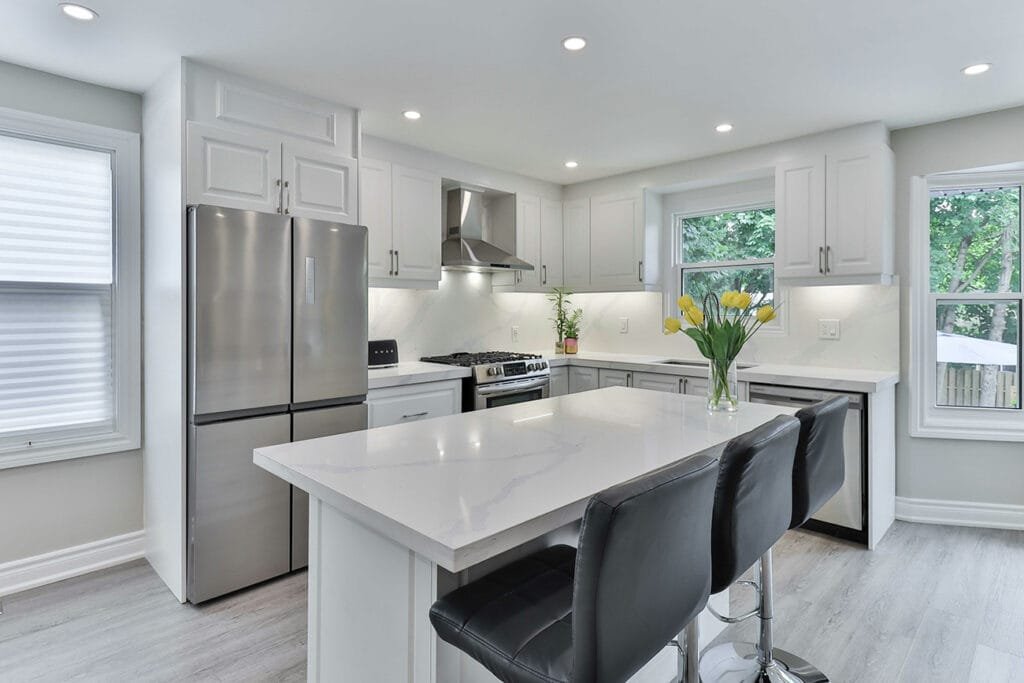
Home Improvement Costs & ROI in Terre Haute
Upgrading the home you already love can be smarter than moving. This guide explains what projects typically cost in Terre Haute, how long they take, and why some upgrades return more value than others. You’ll also see where budgets drift and how to keep schedules realistic without sacrificing quality.
What actually drives cost here
Home improvement budgets in Terre Haute, Indiana rise or fall on a handful of predictable levers. Moving plumbing, gas, or structural elements adds labor and extra inspection steps; keeping utilities in place preserves budget without locking you into a bad layout. Material choices matter too: in-stock, mid-range selections land on time and reduce change orders, while custom or special-order items can add weeks to lead times and ripple through the schedule. Conditions on site such as subfloor repairs, moisture remediation, framing corrections, or electrical service upgrades aren’t glamorous, but they determine how long the work lasts. Finally, coordination with permits and inspections sets the rhythm in Vigo County; when rough-ins and finals are booked early, crews aren’t idling while approvals catch up.
Cost levers to watch
- Scope and layout: avoid moving drains, gas lines, or load-bearing walls unless the payoff is clear
- Materials and lead times: choose durable, in-stock options to keep the start date firm
- Site prep and hidden fixes: subfloor, ventilation, and electrical capacity drive longevity and safety
- Permits and sequencing: plan rough-in/final inspections early to prevent rework and downtime
Typical cost ranges in Terre Haute
Use these as orientation; confirm with a measured, written estimate for your home and selections in Terre Haute, Indiana.
| Project | Typical range |
|---|---|
| Bathroom refresh (no layout move) | $6,500 – $18,000 |
| Walk-in shower or conversion | $4,500 – $22,000 |
| Kitchen surface refresh | $9,000 – $28,000 |
| Deck, 12×16 composite with rails | $12,000 – $24,000 |
| Siding replacement (typical ranch) | $10,000 – $26,000 |
| LVP flooring per level | $3.50 – $6.50 per sq ft labor + materials |
| Basement partial finish | $18,000 – $38,000 |
| Garage or room addition | From $24,000+ |
Bathroom pricing swings with tile vs. solid panels and glass choices. Kitchen budgets hinge on cabinetry decisions (refacing or stock/semi-custom vs. fully custom). Deck totals depend on rail style and stair geometry, while siding costs are driven by elevations, trim details, and existing sheathing condition.
Notes:
- Ranges assume in-stock, mid-range materials and standard permitting in Vigo County.
- Appliances, specialty glass, custom cabinets, and structural moves can add weeks and shift totals.
Which projects tend to return the most value
Return on investment is a guide, not the whole story, but in Terre Haute the upgrades that improve daily function and curb appeal usually perform best at resale.
| Project type | Typical ROI | Typical timeline |
|---|---|---|
| Bathroom remodel | 65–75% | 2–10 days |
| Kitchen upgrade | 70–80% | 1–4 weeks |
| Siding replacement | 60–70% | 1–2 weeks |
| Deck build | ~65% | 3–10 days |
| Flooring install | Value varies | 1–5 days |
How to lift ROI
- Keep layouts disciplined; avoid moving drains or gas unless the payoff is clear
- Choose durable, low-maintenance finishes buyers recognize
- Document the work well with photos and a simple materials list
- Pair one wet-area upgrade (bath/kitchen) with one curb-appeal improvement (siding/door/deck)
Bathrooms: where small scopes move ROI
In Terre Haute, moisture control is the real budget gatekeeper. Solid wall panels with standard glass keep costs predictable, while tile niches, custom glass, and valve upgrades push totals and lead times. If resale is on the horizon, convert a tub to a low-maintenance shower and spend on what lasts: surface-applied waterproofing, a correctly sloped pan, and a quiet, properly sized fan. Buyers notice usability and easy upkeep far more than brand names, and those choices protect the structure long after the photos.
Next step: Compare scopes and timelines on our bathroom page
Kitchens: layout ROI vs. cabinet spend
In Terre Haute, kitchen budgets mostly hinge on cabinetry decisions. Refacing or stock/semi-custom lines keep timelines tight and free up funds for the upgrades buyers actually notice like durable counters, a clean backsplash, and brighter task lighting. Moving gas or a sink often adds inspections and labor without equal payback, so keep utilities in place unless a wall move meaningfully improves workflow. If you’re aiming at resale, prioritize storage efficiency (drawers over doors), good lighting at prep zones, and easy-clean surfaces; they photograph well and live better day to day.
Next step: For homeowners planning their next upgrade, understanding how cabinetry, lighting, and layout interact can make or break a kitchen budget, see our kitchen remodel planning and pricing page for detailed examples of costs, timelines, and layout options.
Decks: rails and stairs set the price
In Terre Haute, deck budgets swing more on rails and stairs than on the board brand. Railing style (composite vs. metal), post caps, and stair geometry add cost quickly; composite or PVC boards pay you back in low maintenance, but keep borders simple if you’re watching totals. Conservative spans and solid connections feel sturdier underfoot and show well at resale, while code-correct guard height and lit stairs help inspections go smoothly.
Next step: For permits, safety, and budget planning, see our deck codes, rails, and layout choices page for clear guidance on spans, railing options, stair geometry, and local permitting.
Siding & trim: spend on the details you can’t see
In Terre Haute, ROI comes from comfort as much as curb appeal. Continuous house wrap, correctly lapped window and door flashing, and vented soffits cut drafts and noise; the visible profile and color do the selling later. If budget is tight, prioritize weather-facing elevations and tricky transitions first (around openings and corners), then phase the rest once the envelope is tight. Proper tie-ins at windows, doors, and trim are what keep paint lines crisp and rooms quieter years down the road.
Next step: For material choices, sequencing, and weather protection details, see our siding systems and water management page for cost drivers, tie-in methods, and practical phasing advice specific to Terre Haute’s climate.
Flooring: continuity is the multiplier
In Terre Haute homes, one continuous LVP across a level makes rooms feel larger and cuts cleaning time. The real cost drivers aren’t the plank label, they’re prep and underlayment. Plan door clearances, transitions, and subfloor fixes before the first box is opened; that’s the difference between a premium, quiet finish and squeaks or lippage later. If resale is a factor, stick with a neutral tone, minimize thresholds, and choose a wear layer that matches traffic (kids, pets, entry paths).
Next step: For material specs and installation prep, visit our flooring page to compare thickness, wear layer, and underlayment options suited to high-traffic areas in Terre Haute homes.
Keeping schedules realistic
Projects move on preparation, not speed promises. Stage core materials before demo so crews aren’t waiting on deliveries. Sequence rough-ins, inspections, and finishing with clean handoffs instead of optimistic overlaps. Lock glass, cabinetry, and specialty doors early to set a credible start date. Short, daily updates keep small issues from turning into multi-day delays, and coordinating inspectors in Terre Haute/Vigo County keeps the critical path clear.
Scheduling habits
- Stage valves, drains, fans, flooring, siding, and rails before demo
- Book rough-in and final inspections as soon as dates are known
- Decide long-lead items first (glass, custom cabinets, special doors)
- Send daily progress notes with next-day tasks and dependencies
Phasing without losing momentum
You don’t have to do everything at once. In Terre Haute, the smartest sequence is to fix water and air issues first, then tighten the envelope, and only after that upgrade finishes and layouts. Start with moisture and ventilation (bathrooms, basements, exterior leaks), then move to siding, doors, and windows so the house is dry and efficient. Once the envelope is stable, kitchens and flooring make more sense, and additions or garages follow when layout truly demands it. If you prefer to keep cash flexible, ask about local financing or plan phases around in-stock materials to hold your start dates.
Phasing roadmap
- Moisture & ventilation: showers, fans, basement dehumidification, exterior leak fixes
- Envelope: siding, door and window replacements, air sealing around openings
- Interiors: kitchen workflow, lighting, and continuous LVP or tile with proper prep
- Expansion: additions or garages after the core house is dry, tight, and efficient
Mistakes that quietly cost the most
In Terre Haute projects, budgets rarely blow up from one big choice, it’s usually a few small misses that stack up. These four are the most common and the most expensive over time.
- Starting demo before key materials arrive
Crews stall, schedules slip, and you risk rework if specs change mid-stream. - Moving utilities or structure without a clear payoff
Every moved drain, gas line, or beam adds labor and extra inspections with little ROI. - Under-specifying ventilation in wet areas and kitchens
Moisture damage, odors, and premature finish failure cost far more than a proper fan or hood. - Choosing finishes before scope and allowances are defined
Upgrades snowball, allowances get blown, and the estimate stops matching reality.
Bringing it together
If your goal is day-to-day comfort now and clean resale later, keep scope disciplined and build around waterproofing, ventilation, and durable, low-maintenance materials. For a broader view of project scopes, pricing ranges, and build process in our market, see home improvements in Terre Haute. One well-planned upgrade often leads to the next with less disruption and better results, especially when inspections, materials, and scheduling are coordinated from the start.
Frequently Asked Questions about Home Improvement Costs in Terre Haute
How much does a typical home improvement project cost in Terre Haute?
Most small updates like flooring or painting start around a few thousand dollars. Mid-range remodels such as bathrooms, kitchens, or decks usually fall between $10,000–$30,000, while larger additions or full basement finishes can reach $25,000–$80,000 depending on materials, scope, and site conditions.
Why do home improvement costs vary so much between projects?
Prices shift with layout changes, material selections, and inspection requirements. Moving plumbing, gas, or structure adds labor and permits; in-stock, mid-range products land faster and reduce downtime.
How long do most remodeling projects take?
Smaller upgrades like flooring or shower conversions can take a few days. Kitchens or siding usually span one to three weeks, and full additions may run longer depending on weather, inspections, and material lead times.
Does financing make sense for home improvements?
It can. Many Terre Haute homeowners use local lenders or home improvement financing to spread costs while keeping cash flexible for future upgrades or maintenance.
Which home improvements give the best return on investment?
Bathrooms, kitchens, and decks consistently lead ROI in Vigo County, often returning 65–80% of project cost. Siding upgrades and flooring continuity improve comfort and resale appeal without major structural changes.
Are Terre Haute building permits required for home improvements?
Yes. Projects involving structural, electrical, or plumbing work typically require permits. Patriot Property Pros manages permits and inspections in-house to keep schedules on track and ensure full code compliance.
How can I keep my project within budget?
Lock your layout early, choose in-stock materials, and confirm allowances before demo. Most overruns happen when finishes change mid-project or hidden site repairs appear after tear-out.

Need further assistance?
Unsure about something? Get in touch with us for a personalized consultation.
Plan your project with clear numbers
Ready to price your upgrade the right way? We’ll measure your space, confirm scope and allowances, handle permits, and give you a clean timeline, so your budget stays predictable from day one. Serving Terre Haute and Vigo County.
Serving Terre Haute, Clinton, Rockville, and surrounding areas.